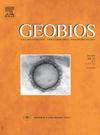Paleoenvironmental reconstruction of a Neogene diatomite deposit from La Pampa Province (Argentina)
IF 1.6
4区 地球科学
Q2 PALEONTOLOGY
引用次数: 0
Abstract
Diatomite deposits constitute siliceous biogenic sedimentary rocks primarily composed of diatoms. In Argentina, there is a scarcity of paleoenvironmental reconstructions for these deposits. This study focuses on the analysis of the diatom content in a Plio-Pleistocene diatomite from La Pampa Province. The aim is to identify diatom diversity and reconstruct the evolution of paleoenvironments. The studied section of 4.40 m is located at the CP site (38°08′40.5’’S; 67°09′23.2’’W, El Sauzal Formation). The profile is a laminated white diatomite with three levels of volcanic ash. Seven samples 50 cm-equidistant were extracted and oxidized with H2O2 for diatom analysis. 500 valves/slide were counted in order to calculate relative abundances. Diatom zones were defined using CONISS. The analysis revealed 72 morphospecies, with 28 of them exhibiting abundances >4%. The diatom flora is predominantly composed of small fragilarioid diatoms accompanied by Discostella, Aulacoseira, Epithemia, Rhopalodia, and Cymbella species, indicating a lacustrine origin. At the base, a paleolake with a relatively alkaline pH, low nitrogen concentrations and high phosphates (volcanic ash) favored the growth of a diverse diatom community. Towards the top, the dominance of fragilarioids, the decrease in freshwater planktonic taxa and the presence of gypsum suggest a shallower environment with increased salinity during the drier periods of the Plio-Pleistocene.
阿根廷拉潘帕省新近系硅藻土矿床的古环境重建
硅藻土矿床是主要由硅藻组成的硅质生物沉积岩。在阿根廷,这些矿床的古环境重建很少。本文对拉潘帕省一块上新世-更新世硅藻土进行了硅藻含量分析。目的是鉴定硅藻多样性,重建古环境演化。4.40 m的研究段位于CP站点(38°08′40.5”S;67°09′23.2”W, El Sauzal地层)。该剖面是一层白色硅藻土,有三层火山灰。提取等距50 cm的7个样品,用H2O2氧化硅藻分析。为了计算相对丰度,对500个阀门/玻片进行计数。用CONISS定义硅藻带。分析发现72种形态,其中28种的丰度为4%。硅藻区系主要由小的易碎硅藻组成,伴有disstella, Aulacoseira, Epithemia, Rhopalodia和Cymbella种,表明湖相起源。在底部,一个pH值相对碱性、氮浓度低、磷酸盐(火山灰)含量高的古湖泊有利于多样化硅藻群落的生长。在顶部,易碎类生物的优势,淡水浮游生物分类群的减少和石膏的存在表明,在上新世-更新世的干燥时期,环境较浅,盐度增加。
本文章由计算机程序翻译,如有差异,请以英文原文为准。
求助全文
约1分钟内获得全文
求助全文
来源期刊

Geobios
地学-古生物学
CiteScore
3.30
自引率
6.20%
发文量
28
审稿时长
6-12 weeks
期刊介绍:
Geobios publishes bimonthly in English original peer-reviewed articles of international interest in any area of paleontology, paleobiology, paleoecology, paleobiogeography, (bio)stratigraphy and biogeochemistry. All taxonomic groups are treated, including microfossils, invertebrates, plants, vertebrates and ichnofossils.
Geobios welcomes descriptive papers based on original material (e.g. large Systematic Paleontology works), as well as more analytically and/or methodologically oriented papers, provided they offer strong and significant biochronological/biostratigraphical, paleobiogeographical, paleobiological and/or phylogenetic new insights and perspectices. A high priority level is given to synchronic and/or diachronic studies based on multi- or inter-disciplinary approaches mixing various fields of Earth and Life Sciences. Works based on extant data are also considered, provided they offer significant insights into geological-time studies.
 求助内容:
求助内容: 应助结果提醒方式:
应助结果提醒方式:


